Silverstone’s summer blowout
With four races in quick succession, Mercedes endured ups and downs, as Max Verstappen battled to prove himself a title contender, says Mark Hughes
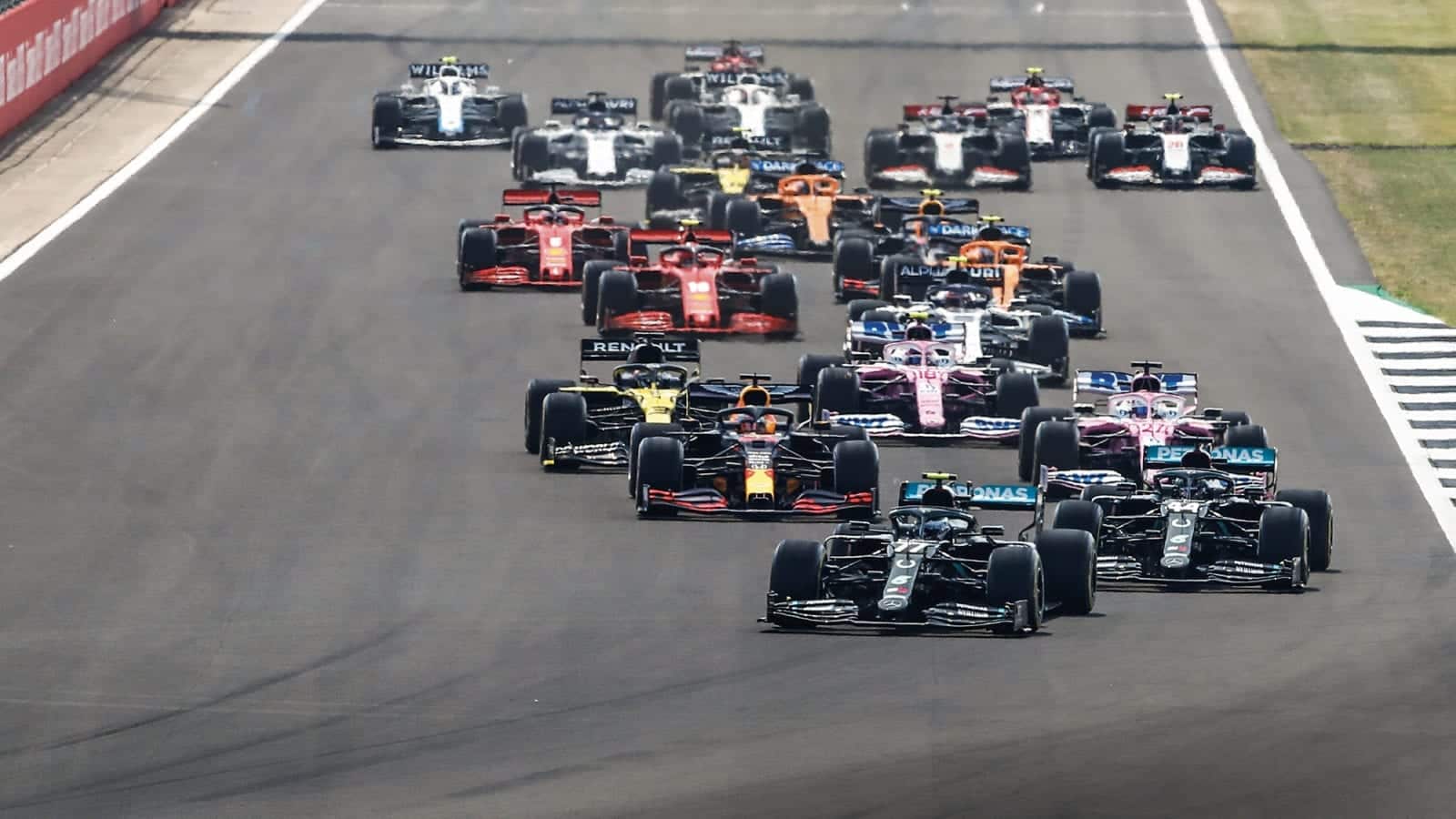
Bottas leads Hamilton away at the start of the 70th Anniversary Grand Prix, but both Mercedes would struggle with tyre troubles
Getty Images
Hungarian GP | British GP | 70th Anniversary GP | Spanish GP
The first three of these four races were brought alive by the drama of jeopardy as various misfortunes fell upon the Mercedes drivers and Red Bull’s Max Verstappen. Lewis Hamilton won both the Hungarian and British Grands Prix, but was pressed at both by the brilliant Verstappen who made his seasonal breakthrough to victory at Silverstone’s 70th Anniversary Grand Prix. More than ever in this era of Mercedes domination, it led to speculation about Verstappen and Red Bull mounting a serious challenge to the current world champions. Such thoughts appeared premature after an emphatic, if unspectacular, victory by Hamilton in Barcelona.
2020 Hungarian Grand Prix
Well, drama didn’t fall upon Verstappen here, he more instigated it. His off into the Turn 12 barriers on the lap to the grid seriously damaged the Red Bull’s front-left suspension. He’d got it going again and the team instructed him not to pit but to drive it to his grid slot, where an attempt at replacing the suspension would be made.
It was Verstappen’s error, though there were extenuating circumstances. There had been a downpour about and hour and three-quarters before the start. Pretty much everyone else was going to the grid on intermediate tyres, but Verstappen – like Hamilton – was keen to explore where the new wet lines were going to be and where the grip was. So he was pushing quite hard to find out. He was also trying to sync eighth gear down the preceding short straight, so had arrived at the corner at higher speed than he’d otherwise have done. Syncing of the gears is the process by which the engine’s management system learns where each gear is in order to optimise the speed of the shifts. If modes have been changed, as likely on a wet track, the computer has to relearn – and to do this you have to engage the gear.
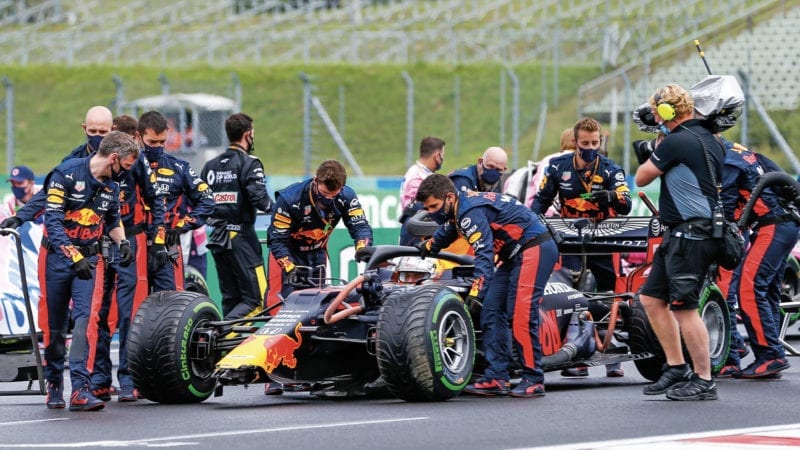
A crisis averted: Verstappen’s off on the formation lap in Hungary was negated by superb teamwork by Red Bull
DPPI
The Red Bull mechanics quickly assessed that neither the wishbones nor the wheel upright looked damaged. Had that not been the case, the car would have been instantly pushed away and retired. Some X-ray scanning equipment was brought onto the grid to verify this. In the meantime, the mechanics busied themselves with replacing a pull rod and track rod and the associated linkages for them. That would normally be a 45-minute job. They had 20 available minutes before the formation lap ‘clear the grid’ signal. Their task was completed with 25sec to spare. “I was sitting in the car and I could see the mechanics screaming at each other ‘10 seconds!’, ‘Five seconds!’ to put the wheel on and the final piece of tape on the suspension,” related Verstappen. “Then I put my thumbs up and they said, ‘Yeah, yeah, away we go’. I was checking the wheel and it felt good as new and then during the race nothing weird happened so it was definitely fully fixed.”
Furthermore, he vaulted from his seventh-place grid slot to third by the first corner and by pitting for slicks a lap later than Lance Stroll’s Racing Point, moved up to second. This was lap four. Lewis Hamilton was already long gone, having pulled an 8sec lead over the field in the first three laps before pitting for slick tyres. The other Mercedes of Bottas fell from the front row to sixth at the first corner after he mistakenly responded to lights on his steering wheel rather than those on the starting gantry.
Haas took the inspired decision not to take up the grid slots of Kevin Magnussen and Romain Grosjean near the back but to pit immediately for slicks and start from the end of the pitlane. This boosted them up to an early third and fourth as everyone pitted. This delayed Bottas’ recovery and by the time the second Mercedes was finally up with Verstappen, the race was 70 per cent done, he no longer had much tyre grip left and he was unable to pass the Red Bull on track. Mercedes brought him in for an extra stop for new tyres on which he closed up on the Red Bull all over again. But never by quite enough, thanks to some traffic delays and a great Verstappen response on old tyres. Hamilton, meanwhile, had built up enough of a gap over Verstappen that he was able to pit for his own brand new set of tyres near the end, enabling him to push and take the extra point for fastest lap.
British Grand Prix
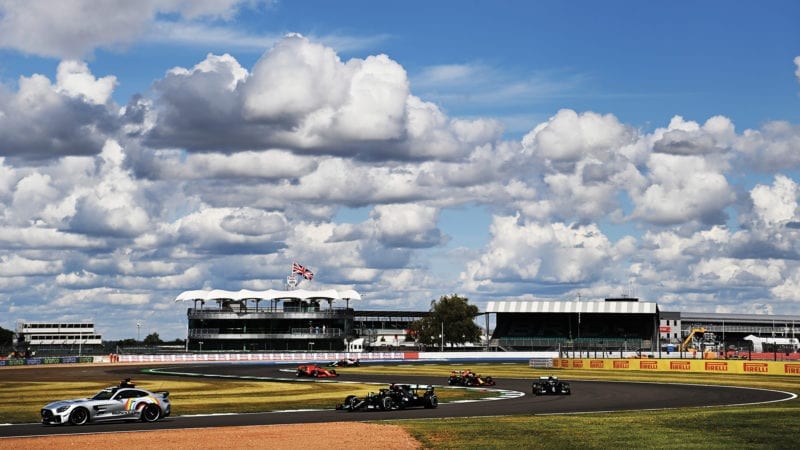
The rather processional British Grand Prix looked like a being another Mercedes whitewash, until the final three laps
Getty Images
Until the front-left tyres began suddenly deflating in the last three laps due to higher than predicted wear, this was shaping into another routine Hamilton and Bottas demonstration of Mercedes superiority. The drama began on lap 50 (of 52) as Bottas rounded Club corner – just after passing the pit entry – and the deflation began. The tyre finally let go fully on the run between Abbey and Village. Hobbling on three tyres for most of the lap back to the pits, he dropped out of the top 10.
That gave Red Bull a terrible dilemma. Bottas’ problem had promoted Verstappen into a distant second place behind Hamilton’s Mercedes, but with more than a pit stop’s-worth of gap back to third. Red Bull was planning to bring him in for a new set of tyres anyway, with which to attack the fastest lap and gain the accompanying extra point. He’d been complaining for some time of a serious vibration from the left front and, having just watched Bottas’ tyre go, it seemed the right thing to do remain with the plan of bringing him in. Especially when the front left of Carlos Sainz’s fourth-place McLaren also let go.
Verstappen pitted. Had he not, his left front might have gone the same way as Bottas’. Or it might have held on – in which case Verstappen would have won because just as the Red Bull was getting ready to pit, the front left of race leader Hamilton deflated as he entered the Wellington straight.
All three of the deflations had left the sidewalls still in place, but detached from the tyre tread. Hamilton desperately tried to maintain some momentum as he completed that last lap with the tyre like this. In his earpiece race engineer Pete Bonnington was counting down the seconds that the new-tyred Verstappen was behind, leaving it up to the driver to decide if he could hang on.
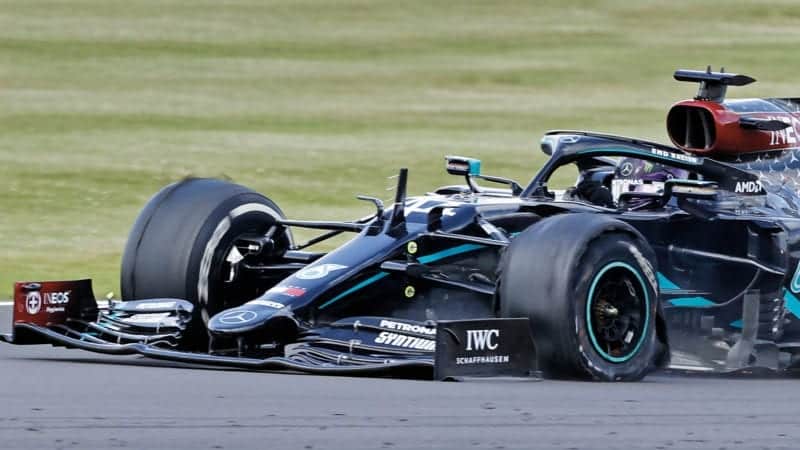
Hamilton’s final British GP lap was stunning, as he calmly battled on with three wheels
Getty Images
“In the heat of the moment you have the adrenalin going and I guess that fight for survival instinct comes out,” Hamilton said after a few minutes of reflection. “I was able to stay calm and really measured and try to bring the car home, but of course I’m just sitting here thinking of all the things that
could have happened; if the tyre gave up in a high-speed corner or something it would have been a much different picture. So I feel incredibly grateful that it didn’t and we just managed, but I heard that Max was catching at crazy speed. I think I got onto Hangar Straight and I could hear ‘you’re at 19 seconds’ at that point and I was trying to pick up the speed down that straight but the wheel was obviously making a real mess and I was thinking ‘Jeez, how am I going to get through these last few corners without losing too much time?’. But fortunately I got round 15 [Stowe] and then once I got to the last two corners that was really when it was a disaster. I could hear ‘seven, six, five…’ and I just managed to keep it together.”

A gamble too far: Verstappen might have won twice at Silverstone had he not made his last British GP stop
Getty Images
Hamilton held on to win from Verstappen and Ferrari’s Charles Leclerc, the latter delivering The Scuderia an unlikely podium with his underwhelming low-downforce/ low-power special.
“No front tyre on the car and he still took Copse and Stowe at more than 130kph,” said an admiring Ross Brawn of Hamilton’s achievement. “He reached 230km/h on the straight with only three wheels and a front-left tyre flailing around – that’s absolutely mind-blowing.”
A subsequent investigation by Pirelli confirmed that the cause of the failures was wear. Because the performance of the tyre remained good until there was no tread left, the teams had no way of monitoring how much tread was left. Everyone had pitted at the first safety car (for a Daniil Kvyat accident at Maggots caused by an overheating wheel-rim breaking the seal with the tyre on his AlphaTauri) with 40 laps still to go, making for stints about 10 laps longer than originally planned. It was enough to take them to that perilous threshold.
70th Anniversary Grand Prix
For this second consecutive Silverstone race, the chosen tyres were one step softer (long planned), which pushed everyone towards a two-stop. But as a precaution against a repeat of the preceding race’s deflations Pirelli had increased the minimum pressures a couple of psi to reduce grip and increase the rigidity of the tyre structure.
Mercedes as usual sewed up the front row (Bottas ahead of Hamilton this time), but it was the car of third-fastest qualifier Nico Hülkenberg that was creating the waves. On the eve of the first practice session came the announcement that the FIA had upheld the Renault protest over the Racing Point’s brake ducts (see feature, page 86). Racing Point had drafted in Hülkenberg as a stand-in for Sergio Pérez, who had tested positive for COVID-19 in the previous week. After eight months out of a car, Hulk had been a little rusty in the first Silverstone qualifying and his engine had refused to start for the race itself. But now, with some extra preparation time, here he was on the second row of the grid – only enhancing the heat of the ‘pink Mercedes’ controversy.
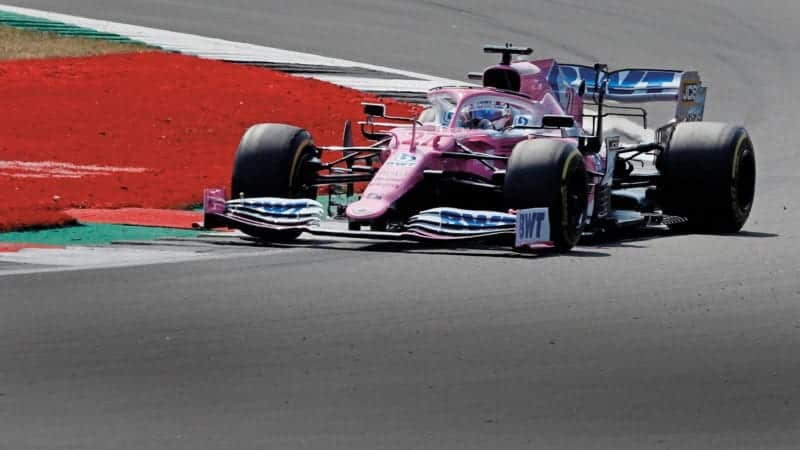
Welcome return, but controversy all the same. Nico Hülkenberg’s pace in the ‘pink Mercedes’ raised some temperatures
Getty Images
At the lights Hulk was passed off the line and left behind by Verstappen and it was the Red Bull which was once more proving the closest thing Mercedes had to an opponent. A much closer one than usual, it seemed. For from around the third lap both race- leader Bottas and the following Hamilton were being troubled by blistering on their medium-compound tyres. It began at the front but soon migrated to the rears. No matter how much they nursed the rubber, the nasty worn black strips around the circumference just got bigger and uglier. Verstappen could see it clearly as he hustled hard right behind Hamilton.
The Red Bull took the lead as the Mercs pitted and – on the hard tyres – Verstappen did a first stint twice as long as theirs. His great pace and the Merc’s struggles even when on the hards helped Verstappen pass Bottas on his out-lap to take the lead. Then he never looked back, just monitoring the gap back to the cautiously-driven Mercs.
Approaching the second stops, Bottas was feeling a serious vibration from the left rear and, given the events of the previous race, Mercedes opted to bring him in quite early. He rejoined but as the team inspected the tyres that had just come off they found that, ugly though the blisters were, there was still plenty of tread on the tyres. This informed them as they guided Hamilton into staying out for another 10 laps after Bottas and Verstappen had pitted.
For a time it looked like Hamilton was going to try to hang on in the lead from the advancing new-tyred Red Bull again, just like the last lap of a week ago. But there was no way his tyres were going to survive – “the risk of a failure at high speed was just too great,” said Hamilton – and he was pitted 10 laps from the end. On fresh rubber, he then also caught and passed Bottas, causing the latter to ask some pointed questions of his team afterwards.
Verstappen looked like he’d barely been trying as he stepped from his winning car. But he wasn’t getting to carried away with things. “I think we just had a really good day with the tyres, and the pace of the car and balance of the car, and probably they [Mercedes] just struggle on the softer tyres so they couldn’t push,” he said. “At the tracks where we go back to tyres where you can push, I don’t think things will be quite as easy for us.”
Spanish Grand Prix
Tyres were again the main challenge in the mid-August heat of Barcelona, but heat degradation this time, rather than blistering or wear. Mercedes and Hamilton were much less compromised by this particular type of tyre management than those of Silverstone. Once he broke free of an early- chasing Verstappen, he took a resoundingly dominant victory, and in doing so recorded his 156th grand prix podium finish, surpassing Michael Schumacher’s record.
After giving the tyres 10 laps to stabilise before pushing, Hamilton was in a different league. “As soon as he did that, I thought, ‘Ok, that’s me done for the day,” said Verstappen. The Red Bull driver over- delivered in keeping the Mercedes of Bottas behind to the end. The fourth and fifth place Racing Points of Stroll and a returning Pérez were a lap down by the end.
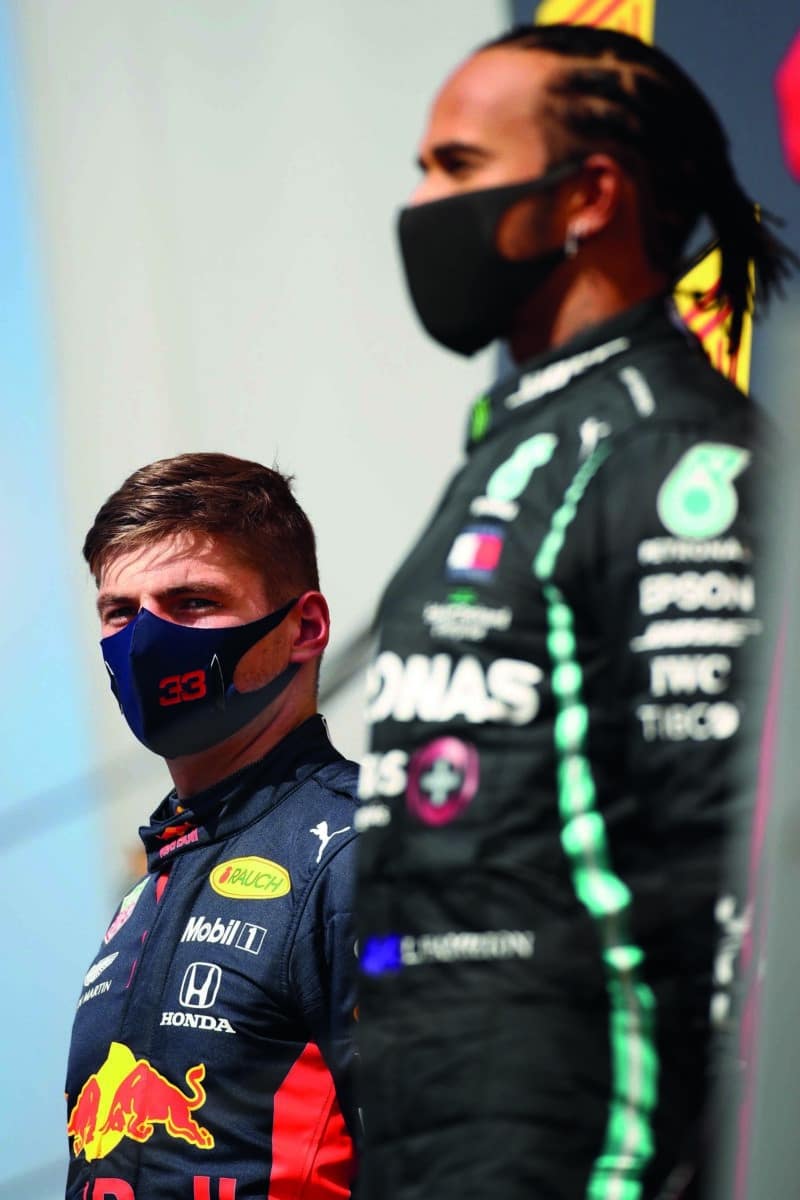
Playing second string one week, and triumphant the next. His strong month moved Max Verstappen to second in the drivers’ championship, albeit still 37 points down on leader Hamilton
Getty Images
